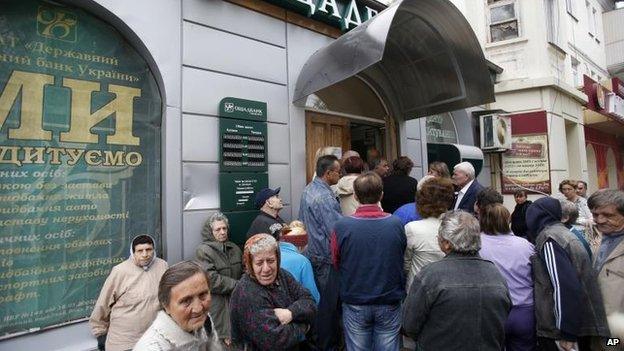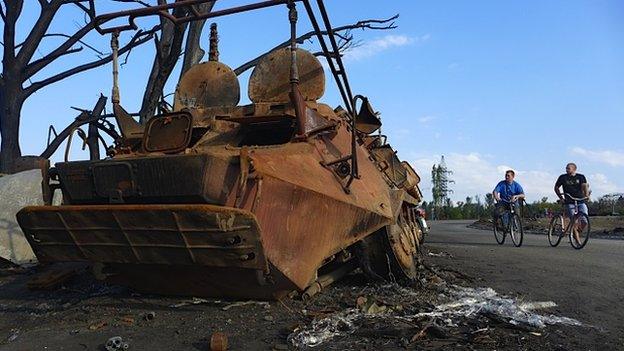Grim Luhansk wary of Ukraine's shaky truce
- Published
The BBC's Paul Adams reports from Luhansk in eastern Ukraine
Luhansk is licking its wounds. After a long summer of bombardment by government forces, it is mourning its dead and slowly coming back to life.
But it is a grim, pessimistic place, full of hardship and queues.
Under a green tent, a quiet line of grateful citizens waits for a decent plate of food, courtesy of one the few soup kitchens operating across the city.
There is still no electricity or water in the city, so thousands of people depend on handouts.
Rebellious past
I find Anatoly Bukhalov sitting alone in the corner. When he finds out we're from Britain, he breaks into song, rattling off the chorus of Back in the USSR.
He used to sing Beatles covers with a college band, back in 1969. It nearly got him thrown out.
His face lights up when he recalls his rebellious past, but when we talk about Luhansk today, he despairs.

A convoy of 220 Russian aid trucks arrived in Luhansk last weekend
"Some say the fighting will start again tomorrow," he says. "That there will be bombing again. No-one is saying tomorrow will be better."
Anatoly makes a point of thanking Vladimir Putin for coming to the city's help. A convoy of 220 trucks arrived in the city last weekend, carrying food and other humanitarian supplies.
We find some of the aid being housed in an industrial warehouse. Boxes of bandages and tourniquets are piled high to the ceiling.
With fighters and civilians all talking about further conflict, it's hard not to see supplies like this as part of their preparations.

Queues are frequent both in Luhansk and here in Donetsk
If a political agreement is not reached and the shaky ceasefire breaks down completely, Luhansk could be in for a repeat of the last few punishing weeks.
For the most part, the city itself is not badly damaged, but weeks of fighting and government shelling have laid waste to some outlying areas.
Vital lifeline
In the village of Khryashchuvate there's barely a house intact. Many have been demolished entirely. Power lines are down, wrecked armoured vehicles are rusting under the trees and spent ammunition litters the ground.
We arrive to find a water truck, and another line of patient people. During the fighting, those who could fled to nearby Russia. Those who stayed hid in their basements while shells fell all around.
The water truck started coming to the village just four days ago. For weeks it was simply too dangerous. Now, it's a vital lifeline.
I meet Alexander, carrying buckets and bottles, making repeated round trips to this damaged house. He and his family only emerged from their shelter 10 days ago.

Questions remain about the extent of Russian involvement in destroying Ukrainian units

Destroyed government armoured vehicles lie on the road leading south from Luhansk
"There was bombing for three weeks," he tells me. "Day and night. We were sitting in the basement all the time."
One shell destroyed his kitchen and damaged his roof.
He, too, thinks the fighting will start again, but he's not planning to leave.
On the steps down to his shelter sit two tin pails of home-grown tomatoes, and jam jars waiting to be filled.
"We've experienced it already," he says of the fighting. "We're used to it, so we'll stay here."
As we leave and head south, we come across the bleak, twisted remains of a government armoured convoy, annihilated as it retreated from Luhansk two weeks ago.
It's a terrifying scene of complete destruction. A dozen or more tanks, trucks and armoured personnel carriers ripped open and blown apart amid craters and bare, blackened tree trunks.
This was ferocious work, involving more precise firepower than the rebels can possibly muster. It's possible Russian helicopters were involved.
The grim place serves as a reminder that if the ceasefire collapses totally, Ukraine's powerful neighbour to the east is unlikely to stand by and watch.